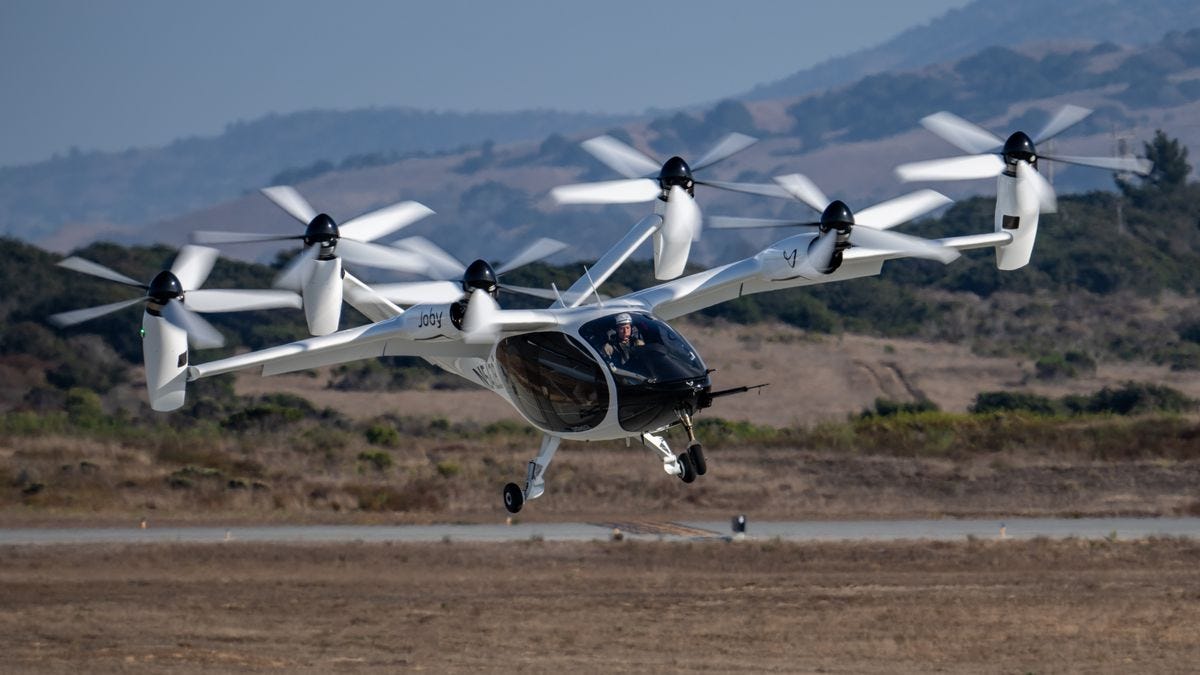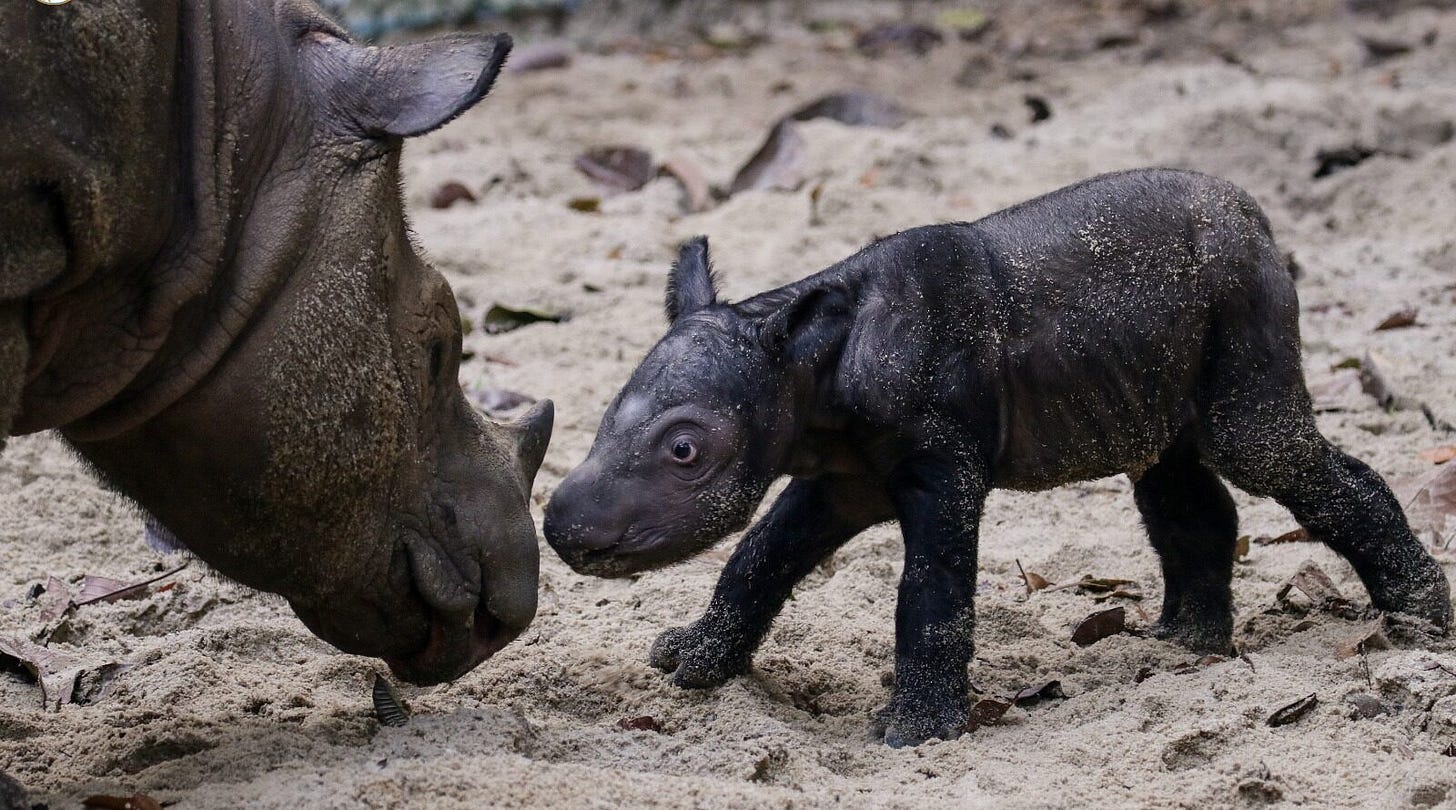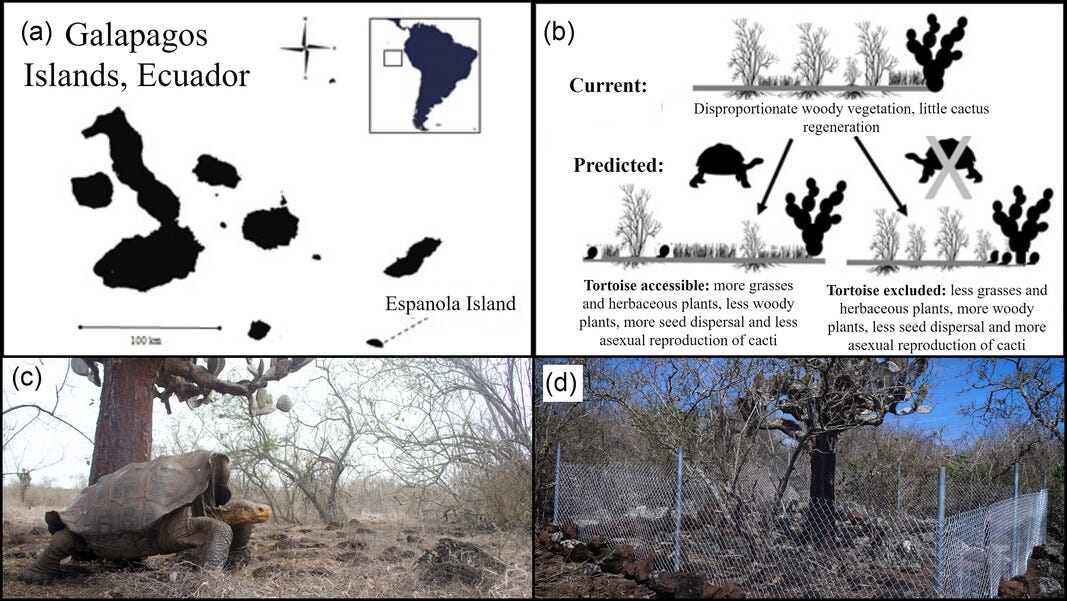The Weekly Anthropocene, October 18 2023
Electric flying taxis are taking off, a new Sumatran rhino calf, ecosystem benefits from Galapagos tortoise rewilding, vaccinating California condors, quantifying carbon storage, and more!
United States

With little public fanfare, an amazing new technology is being born: honest-to-goodness flying cars. Electric flying cars, made possible by the ongoing world-transforming revolution in battery technology. More precisely, electric vertical take-off and landing aircraft (eVTOLs), essentially extra-large people-carrying battery-powered drones. (Or, if you prefer, extra-quiet zero-emissions vertical takeoff-friendly helicopters). eVTOLs have moved in recent years from a long-held dream of science fiction to a nascent reality, with applications ranging from flying taxis to military and first-responder actions to single-person sport vehicles.
The US Air Force is testing the capabilities of a fully-functional flying taxi right now, with Edwards Air Force Base taking delivery from burgeoning eVTOL manufacturer Joby on September 25, 2023. Joby is also financially backed by Delta Air Lines and claims that it will offer Uber-priced rides in its five-person flying taxis between airports and city centers starting in 2025. A rival eVTOL maker named Archer is backed by United Airlines and also claims it will start Uber-style commercial airport-to-city flying taxi rides in 2025. Both hope to scale up fast after that; Joby is planning a factory in Ohio, and Archer is planning a factory in Georgia. Over in Europe, a German eVTOL company called Volocopter is flying at the Paris Air Show and trying to seal a deal to offer passenger flights for the Paris 2024 Summer Olympics. (Volocopter has also signed agreements to operate in Singapore). Another company called Wisk is testing their flying-taxi eVTOL model out of Long Beach Airport near Los Angeles.
Beyond these early leaders, a wide range of early companies are trying to deliver on further aspects of eVTOLs’ futuristic promise. A startup, Jetson, is building a one-person ultralight “sport” eVTOL strongly reminiscent of a Star Wars speeder, and has already sold out early production lines ahead of a planned 2024 launch. Another, Pivotal, will soon be selling the Helix, another attempt at a “flying motorcycle.” Even more ambitious vehicles are on the drawing board.
eVTOLs may seem like a toy for rich people at first, but new technology has a habit of starting out that way before becoming cheaper and widely useful. Small quadcopter-type drones seemed like toys at first, and now they’re doing vital, transformative work from delivering medical supplies in sub-Saharan Africa to aerial reforestation around the world. This writer is excited to see how the dawn of eVTOLs!
The Department of Energy approved a $3 billion partial loan guarantee to fund Project Hestia, in which solar company Sunnova will offer loans for 75,000 to 110,000 American homeowners to set up rooftop solar and home battery systems. This will eventually add up to a synchronized 568-megawatt virtual power plant (when a bunch of independent power producers like home solar & batteries are software-coordinated so they can respond together to grid demand, playing the same role as a physical power plant). This Project Hestia funding is the largest single commitment ever from the US federal government to a solar power project. Great news!
The Biden Manufacturing Boom continues! Battery maker LG will invest an extra $3 billion in their Michigan factory as part of a new deal to produce lithium-ion batteries for Toyota EVs.
Construction is beginning on Maryland’s first completely energy self-sufficient affordable housing development, with rooftop solar, battery storage, and a community microgrid. The homes will be marketed to “first-time homebuyers earning 80% or less of the area’s median income.”
Work has begun on three new solar-plus-battery storage projects in Mississippi, which will add up to a total of 550 MW of solar capacity and 150 MW of storage.
An electric Tesla Model Y is now cheaper than the average new gas-powered car in the United States—thanks in part to Inflation Reduction Act EV tax rebates! Electric vehicles accounted for around 7% of new cars sold in America in the first half of 2023, and other countries’ experience shows that EV sales tend to grow extremely rapidly once they cross the 5% tipping point.
California’s governor signed into law a new bill to speed up consumer interconnection to the grid, directing the California Public Utilities Commission to set “reasonable average and maximum target energization time periods.” Long waiting lines for grid connection have become an increasing problem as America and the world see an electric building boom, so it’s great to see a major economy like California getting to work on tackling that!
Indonesia
The Sumatran rhino is perhaps the world’s most endangered large land mammal, with as few as 34 left in the wild. Now, the Indonesian government has announced on September 10th the birth of a female calf at the Sumatran Rhino Sanctuary in Way Kambas National Park. With the new arrival, there are now 10 Sumatran rhinos in captivity. A new spark of hope for the future of the species!
Mexico
Vaquitas (Phocoena sinus) are both the tiniest and the most endangered cetacean on Earth. Native to Mexico’s Gulf of California, they’re smaller than humans at only 1.5 meters long, and there are as few as ten individuals left1. They’re primarily at risk from being killed as bycatch during illegal fishing of totoaba, so the nonprofit group Sea Shepherd has worked for years to remove illegal gill nets—they estimate that this work reduced hours of illegal fishing by 79% in 2022.
Now, Sea Shepherd has signed a new agreement with the Mexican government to expand the area of gill net removal efforts by over 60%, hopefully developing a bigger, better-defended safe haven for the tenacious vaquitas to have a chance at growing their numbers. Great news!
California Condors

California condors are a classic conservation success story, with captive breeding and assiduous wild-habitat conservation efforts helping their population rise from just 22 individuals in 1982 to 561 in 2022. However, they’ve recently faced a new threat: the globe-spanning H5N1 bird flu outbreak, which killed 21 wild condors in three weeks. Conservationists feared that it would spread throughout the population.
Now, the USDA has approved the use of an experimental bird flu vaccine to help protect the condors, and it’s already paying off. After successful tests on a related vulture species, 20 captive condors have so far been vaccinated with no ill effects, and if all goes well the next “class” of captive-bred condors will be vaccinated before being released into the wild. An awesome confluence of two of humanity’s most noble endeavors: wildlife conservation and vaccines! Excellent work.
Ecuador
A new study has found that a decades-long project that reintroduced 2,000 Galapagos giant tortoises to Ecuador’s Isla Española has been highly successful, with the chelonian ecosystem engineers bringing a cascade of benefits for many other species. They eat cactus fruit and disperse their seeds, for example, facilitating their reproduction. Furthermore, the tortoises’ grazing and trampling of plants has “cleared runways” for the critically endangered waved albatross to take off and land, making it easier for them to access the island where they breed. Another awesome rewilding victory! Great news.
Earth’s Forests

A landmark new study (here’s the PDF) quantifies changes in the amount of carbon stored by Earth’s land plant biomass from 2010 through 2019, using satellite sensing of “L-band microwave vegetation optical depth,” which “probe live woody vegetative biomass components owing to the higher penetration of low-frequency radiation within the canopy layer.”
They found that on overall, tropical forests were net carbon sources in the 2010s (due to deforestation, fires, and agriculture), while young, fast-regrowing temperate and boreal forests were substantial carbon sinks (i.e. absorbing carbon, which is what we want). This added up to a net increase in the overall amount of carbon Earth’s forests are storing, of about 500 million tonnes per year. Here’s a direct quote from their abstract:
The main contributors to the global carbon sink are boreal and temperate forests, while wet tropical forests are small carbon sources, from deforestation and agriculture-related disturbances. We found that the tropical deforested and degraded old-growth forests (>140 yr) are nearly carbon neutral whereas temperate and boreal young (< 50 yr) and middle-aged (50–140 yr) forests are the largest sinks.
-Yang et al. (2023), Global increase in biomass carbon stock dominated by growth of northern young forests over past decade
So we have progress to build on for temperate and boreal forests, and more work to do to protect tropical forests. Brazil’s recent successes, since the period studied, are a great step in this direction. Great research!
Captive breeding might seem indicated here, as it’s helped many endangered species recovery from similarly ultra-low population numbers (e.g. the black-footed ferret, Arabian oryx, and black robin) but we’ve learned the hard way that it doesn’t work for vaquitas.






